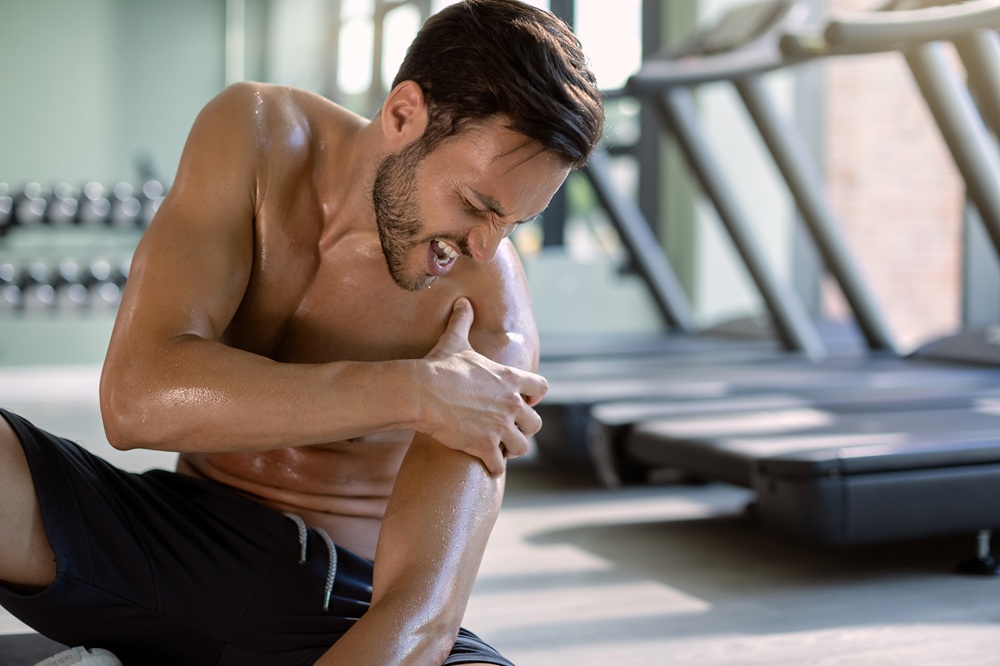Muscle strain – causes, symptoms, prevention

Muscle strain is a common injury caused by overstretching muscle fibers beyond their natural capacity to adapt. It presents as sharp pain and, although usually not serious, requires proper treatment.
How long does muscle strain hurt? What causes muscle strain? Are elastic bandages, painkillers, or cold compresses recommended treatments? What are the symptoms of muscle strain?
Table of contents
- Muscle strain - causes, symptoms, prevention
- What is a muscle strain?
- Causes of muscle strain
- Muscle strain - symptoms
- Back muscle strain
- Strained thigh muscle
- Calf muscle strain
- Shoulder muscle strain - symptoms
- What to do with a pulled muscle? Treatment for a pulled muscle
- Strained muscle - home remedies
- How long does it take for a strained muscle to heal?
- How to prevent muscle strains?
- Training mistakes that increase the risk of injury
What is a muscle strain?
Muscles consist of muscle fibers called myofibrils, which can contract and relax, allowing the body to move. However, sometimes muscles are subjected to forces beyond their natural ability to adapt, causing damage to the fibers and potentially leading to inflammation.
There are three main types of muscle injuries:
- muscle strain,
- muscle tear,
- muscle rupture.
A muscle strain involves damage to less than 5% of the muscle fibers. A muscle tear means more than 5% of the myofibrils are torn, while a muscle rupture is a complete, 100% tear of the muscle.
Therefore, a muscle strain is an injury caused by excessive stretching of the myofibrils, overloading the fibrous tissue, and potentially causing inflammation within the muscle. Muscle strains differ from muscle tears mainly in the extent of damage and symptom severity, with strains typically requiring a shorter recovery time than tears.
Causes of muscle strain
Muscle strain most often occurs as a result of sudden movements or overuse of muscles and tissues. An increased risk of muscle strain can be seen in people who engage in intense physical activity without first performing a proper warm-up, which lowers the muscles’ resistance to stretching and can lead to damage, as well as in athletes who overexert themselves during training and competitions (usually due to fierce competition or technical errors).
Calf muscle strains are most commonly observed in athletes who train in running or basketball, while upper limb muscle strains may affect, for example, those who practice gymnastics or tennis.
Muscle strain can also be caused by irregular exercise habits, particularly inconsistent stretching and strengthening activities. Muscle structures can also be negatively affected by mechanical force applied to tense muscles during impacts or falls, as well as frequent microtraumas, which, through accumulation and repetition of minor injuries, can lead to more serious damage.
Muscle strain - symptoms
The severity and type of symptoms can vary depending on the location of the muscle strain and the extent of the damage.
A strained muscle most often causes intense pain at the site of the injury, which can be described as burning, stinging, or sharp. The pain usually worsens with movement.
Additionally, symptoms of muscle strain may include:
- redness,
- swelling,
- bruising,
- puffiness,
- limited range of motion in the joint,
- tenderness at the injury site,
- weakness,
- muscle spasms.
Back muscle strain
Back muscle strain most commonly results from improper lifting of heavy objects and usually affects the lumbar region, although other parts of the spine can also be injured.
A back strain may cause severe, diffuse, and radiating pain, which can worsen with movements such as twisting the torso or lifting heavy objects. In cases of back muscle strain, limited mobility may also be noticed, making everyday activities difficult, along with swelling and redness around the injured muscle.
Strained thigh muscle
Lower limb muscle strains are among the most common injuries, especially in athletes who regularly engage in intense physical activity.
A strain of the biceps femoris or the quadriceps femoris muscle can cause difficulty in movement and lead to swelling at the injury site. Additionally, a strained thigh muscle causes severe, sharp pain and often internal bleeding at the injury location.
Calf muscle strain
Calf muscle injuries are most commonly seen in runners, but calf strains can also affect athletes in sports such as soccer, basketball, or skiing.
A calf muscle strain usually causes tenderness at the injury site, along with muscle weakness, which may be noticeable when climbing stairs or standing on tiptoes. The injured calf may also be swollen, and mobility around the injury may be limited.
Shoulder muscle strain - symptoms
People who perform repetitive movements or whose work involves lifting their arms are especially prone to shoulder muscle injuries.
Straining the muscle fibers in the shoulder area typically causes localized, throbbing pain that may worsen when lifting the arms upward. Additionally, a strained shoulder muscle, like other muscle injuries, can cause swelling, redness, or bruising at the injury site, along with weakness in the affected area.
What to do with a pulled muscle? Treatment for a pulled muscle
First aid for a pulled muscle, regardless of the injury’s location, involves following the RICE protocol (Rest, Ice, Compression, Elevation). This means the first step is to rest and apply cold to the strained muscle, followed by applying compression and elevating the injured area. According to the RICE method, resting and cooling the painful area is especially important during the first 48 hours after the injury. Compression, for example with an elastic bandage, can help reduce swelling. The final step, elevation — raising the limb above heart level — helps lower hydrostatic pressure, reducing the buildup of fluid between cells.
Therefore, although a common question after muscle injury is ‘cold or heat — which should I choose?’, the RICE protocol clearly recommends cold compresses on the injury site. Cold helps reduce muscle pain by constricting local blood vessels and slowing the spread of inflammation. Heat, on the other hand, can be beneficial once the acute inflammation has passed.
In addition, when considering what might help a strained muscle, it is worth thinking about using:
- pain relief ointments, gels, and tablets, which should be applied 48 hours after the injury, once the acute inflammation has decreased. These can positively affect blood vessels, speeding up the healing and regeneration of damaged tissues while easing pain;
- kinesiotaping, massage, and physical exercises — treatments that help reduce pressure on pain receptors, improve blood and lymph circulation, and decrease bruising. Massage can also support muscle healing by promoting tissue regeneration, while physical exercises like stretching can relieve pain and enhance overall well-being.
Strained muscle - home remedies
In addition to specialist-recommended treatments, there are also home remedies for strained muscles that can help relieve pain and support the healing process of damaged tissues.
Effective home remedies for strained muscles include:
- applying ice packs to the injured area,
- after 48 hours, using warm compresses on the injury site,
- gently rolling or massaging the injured muscle,
- including anti-inflammatory foods in your diet, such as turmeric or chili pepper,
- regularly performing gentle massages on the affected area,
- resting and avoiding muscle strain,
- using herbs and plant-based remedies that may reduce inflammation, such as St. John’s wort, calendula, ginger, cinnamon, Japanese knotweed, or plantain.
How long does it take for a strained muscle to heal?
A strained muscle is usually identified by a specific pain that worsens when touched or moved. Although the duration of pain and the healing process varies individually — depending on personal factors, the injury location, and the severity of the strain — pain symptoms typically lessen within 1–2 days after the injury.
Available data show that muscle pain generally lasts from a few days up to a week, and most athletes can expect to fully recover within 7–14 days. However, in cases of acute inflammation or severe muscle strain, recovery may take up to 3 weeks. It is also important to consult a doctor or qualified physiotherapist if the pain persists for an extended period.
How to prevent muscle strains?
To prevent muscle strains, appropriate preventive measures should be taken. Therefore, before starting physical activity, it is important to warm up the whole body properly, and after finishing the workout, take time for stretching exercises.
In addition, it is advisable to listen to your body's needs without overloading it. When lifting heavy objects, it is important to maintain proper posture and use the correct technique, while when playing sports, you should avoid technical mistakes by using the right equipment and well-fitting shoes.
It is also worth paying attention to proper hydration and a healthy and balanced diet that provides the body with all the necessary macro- and micronutrients, including protein, which can indirectly help improve muscle endurance. The use of herbs with anti-inflammatory properties, such as OstroVit Curcumin + Black Pepper + Ginger VEGE 90 capsules, as well as the inclusion of appropriate dietary supplements in the daily menu, such as:
- Vitamin D, e.g., OstroVit Vitamin D3 4000 IU 120 capsules, which helps maintain healthy bones and muscles while reducing the risk of injuries by accelerating muscle regeneration;
- Vitamin C, e.g., OstroVit Vitamin C 1000 mg 90 tablets, which supports collagen production — an essential component of muscles, tendons, and ligaments;
- Omega-3 fatty acids, e.g., OstroVit Omega 3 180 capsules, which have anti-inflammatory properties and aid muscle regeneration;
- Whey protein, e.g., OstroVit WPC 80 700 g natural, which helps build muscle and supports their recovery;
- Collagen, e.g., OstroVit Marine Collagen + Hyaluronic Acid + Vitamin C 120 capsules, which provides valuable support in repairing microtraumas and rebuilding damaged muscle tissue.
Training mistakes that increase the risk of injury
To prevent muscle strains, it is important to avoid training mistakes that increase the risk of injury and overstrain certain muscle groups. Therefore, warming up before exercise is essential, as it raises body temperature and improves muscle flexibility. Studies suggest that 10–15 minutes of dynamic exercises, such as arm circles, leg swings, or jogging in place, are sufficient to prepare the body for intense physical activity.
Additionally, to reduce the chance of muscle strain, proper exercise technique should be followed, including correct foot and knee positioning and controlled movements. It is also crucial to choose appropriate weights for your workouts and avoid increasing them too quickly, as this can cause muscle overload and fatigue, raising the injury risk.
Another key point is using recommended equipment during physical activities that require it. For example, in combat sports, wearing protective gear and a helmet is necessary, while in climbing, suitable footwear and safety equipment, including helmets, should be used.

